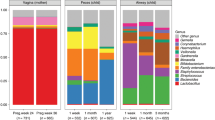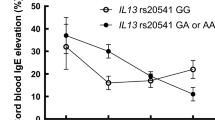Abstract
Background
Prenatal maternal diet may influence disease susceptibility in offspring with specific genetic backgrounds. We hypothesized that interactions between prenatal antioxidant intake and polymorphisms in immunity genes influence respiratory tract infection (RTI) susceptibility in infants at 12 months of age.
Methods
This study included 550 infants. In the Cohort for Childhood Origin of Asthma and Allergic Diseases (COCOA) birth cohort study, prenatal maternal diet was assessed by administering a food frequency questionnaire. Infants’ cord blood was genotyped for CD14 (rs2569190), TLR4 (rs1927911), and GSDMB (rs4794820) polymorphisms by the TaqMan method.
Results
Higher prenatal intake of total fruit and vegetables (FV) was associated with the decreased risk of RTI in offspring (P-trend=0.0430). In children with TT genotype at rs2569190, a higher prenatal intake of vitamins A and C, fruits, and total FV decreased RTI risk (P-trend <0.05), while in infants with TC+CC genotype, a higher prenatal intake of fruit increased RTI risk (P-trend <0.05). When analyzing the 3 genotypes, children with TT genotype at rs2569190 were more protected against RTIs compared with those with CC genotype with respect to vitamin C and fruits [odds ratio (OR)=5.04 and OR=10.30, respectively]. In children with CC genotype at rs1927911, RTI risk showed a dose–response association with a higher prenatal intake of vitamin C (P for interaction<0.05). A higher prenatal intake of fruits and total FV reduced RTI risk in infants with GA+AA genotype of rs4794820 (P for interaction<0.05).
Conclusions
Prenatal antioxidant intake may reduce RTI risk in infants and this relationship may be modified by CD14, TLR4, and GSDMB polymorphisms.
Similar content being viewed by others
References
Waterland RA, Michels KB. Epigenetic epidemiology of the developmental origins hypothesis. Annu Rev Nutr 2007;27:363–388.
Martino D, Prescott S. Epigenetics and prenatal influences on asthma and allergic airways disease. Chest 2011;139:640–647.
Leavy O. Asthma and allergy: Diet and airway inflammation. Nat Rev Immunol 2014;14:64–65.
Scrimshaw NS, Taylor CE, Gordon JE. Interactions of nutrition and infection. Geneva: World Health Organization, 1968.
Scaife AR, McNeill G, Campbell DM, Martindale S, Devereux G, Seaton A. Maternal intake of antioxidant vitamins in pregnancy in relation to maternal and fetal plasma levels at delivery. Br J Nutr 2006;95:771–778.
Prescott SL. Allergic disease: understanding how in utero events set the scene. Proc Nutr Soc 2010;69:366–372.
West CE, Videky DJ, Prescott SL. Role of diet in the development of immune tolerance in the context of allergic disease. Curr Opin Pediatr 2010;22:635–641.
Webb AL, Villamor E. Update: effects of antioxidant and nonantioxidant vitamin supplementation on immune function. Nutr Rev 2007;65:181–217.
Alberti-Fidanza A, Di Renzo GC, Burini G, Antonelli G, Perriello G. Diet during pregnancy and total antioxidant capacity in maternal and umbilical cord blood. J Matern Fetal Neonatal Med 2002;12:59–63.
Wu G, Bazer FW, Cudd TA, Meininger CJ, Spencer TE. Maternal nutrition and fetal development. J Nutr 2004;134:2169–2172.
Dominguez-Salas P, Cox SE, Prentice AM, Hennig BJ, Moore SE. Maternal nutritional status, C(1) metabolism and offspring DNA methylation: a review of current evidence in human subjects. Proc Nutr Soc 2012;71:154–165.
Singh U, Devaraj S, Jialal I. Vitamin E, oxidative stress, and inflammation. Annu Rev Nutr 2005;25:151–174.
Gore AB, Qureshi MA. Enhancement of humoral and cellular immunity by vitamin E after embryonic exposure. Poult Sci 1997;76:984–991.
Mizgerd JP. Lung infection—a public health priority. PLoS Med 2006;3:e76.
Tregoning JS, Schwarze J. Respiratory viral infections in infants: causes, clinical symptoms, virology, and immunology. Clin Microbiol Rev 2010;23:74–98.
Morcillo EJ, Estrela J, Cortijo J. Oxidative stress and pulmonary inflammation: pharmacological intervention with antioxidants. Pharmacol Res 1999;40:393–404.
Brandsma E, Houben T, Fu J, Shiri-Sverdlov R, Hofker MH. The immunity-diet-microbiota axis in the development of metabolic syndrome. Curr Opin Lipidol 2015;26:73–81.
Vial G, Dubouchaud H, Couturier K, Cottet-Rousselle C, Taleux N, Athias A, et al. Effects of a high-fat diet on energy metabolism and ROS production in rat liver. J Hepatol 2011;54:348–356.
Lee IT, Yang CM. Role of NADPH oxidase/ROS in proinflammatory mediators-induced airway and pulmonary diseases. Biochem Pharmacol 2012;84:581–590.
Surh YJ, Kundu JK, Na HK. Nrf2 as a master redox switch in turning on the cellular signaling involved in the induction of cytoprotective genes by some chemopreventive phytochemicals. Planta Med 2008;74:1526–1539.
Parker D, Prince A. Innate immunity in the respiratory epithelium. Am J Respir Cell Mol Biol 2011;45:189–201.
Kitchens RL, Munford RS. CD14-dependent internalization of bacterial lipopolysaccharide (LPS) is strongly influenced by LPS aggregation but not by cellular responses to LPS. J Immunol 1998;160:1920–1928.
Hailman E, Vasselon T, Kelley M, Busse LA, Hu MC, Lichenstein HS, et al. Stimulation of macrophages and neutrophils by complexes of lipopolysaccharide and soluble CD14. J Immunol 1996;156:4384–4390.
Wei J, Rahman S, Ayaub EA, Dickhout JG, Ask K. Protein misfolding and endoplasmic reticulum stress in chronic lung disease. Chest 2013;143:1098–1105.
Kim HB, Ahn KM, Kim KW, Shin YH, Yu J, Seo JH, et al. Cord blood cellular proliferative response as a predictive factor for atopic dermatitis at 12 months. J Korean Med Sci 2012;27:1320–1326.
Oh SY, Kim EM, Shin MHL, Lee SH, Kim JE, Lee HS. Development and validation of food frequency questionnaire for adults. Seoul, Korea: The Korean Society of Health Promotion Annual Spring Conference, 2007:67–72.
Willers SM, Devereux G, Craig LC, McNeill G, Wijga AH, Abou El-Magd W, et al. Maternal food consumption during pregnancy and asthma, respiratory and atopic symptoms in 5-year-old children. Thorax 2007;62:773–779.
Dhur A, Galan P, Hercberg S. Folate status and the immune system. Prog Food Nutr Sci 1991;15:43–60.
West CE, Dunstan J, McCarthy S, Metcalfe J, D’Vaz N, Meldrum S, et al. Associations between maternal antioxidant intakes in pregnancy and infant allergic outcomes. Nutrients 2012;4:1747–1758.
Miyake Y, Sasaki S, Tanaka K, Hirota Y. Consumption of vegetables, fruit, and antioxidants during pregnancy and wheeze and eczema in infants. Allergy 2010;65:758–765.
Litonjua AA, Rifas-Shiman SL, Ly NP, Tantisira KG, Rich-Edwards JW, Camargo CA Jr, et al. Maternal antioxidant intake in pregnancy and wheezing illnesses in children at 2 y of age. Am J Clin Nutr 2006;84:903–911.
Bruckdorfer KR. Antioxidants and CVD. Proc Nutr Soc 2008;67:214–222.
Marchese ME, Kumar R, Colangelo LA, Avila PC, Jacobs DR Jr, Gross M, et al. The vitamin E isoforms alpha-tocopherol and gamma-tocopherol have opposite associations with spirometric parameters: the CARDIA study. Respir Res 2014;15:31.
Patel A, Liebner F, Netscher T, Mereiter K, Rosenau T. Vitamin E chemistry. Nitration of non-alpha-tocopherols: products and mechanistic considerations. J Org Chem 2007;72:6504–6512.
Cook-Mills JM, Abdala-Valencia H, Hartert T. Two faces of vitamin E in the lung. Am J Respir Crit Care Med 2013;188:279–284.
Cunningham-Rundles S, McNeeley DF, Moon A. Mechanisms of nutrient modulation of the immune response. J Allergy Clin Immunol 2005;115:1119–1128;quiz 1129.
Serafini M. Dietary vitamin E and T cell-mediated function in the elderly: effectiveness and mechanism of action. Int J Dev Neurosci 2000;18:401–410.
Yang Y, Bazhin AV, Werner J, Karakhanova S. Reactive oxygen species in the immune system. Int Rev Immunol 2013;32:249–270.
Malireddy S, Kotha SR, Secor JD, Gurney TO, Abbott JL, Maulik G, et al. Phytochemical antioxidants modulate mammalian cellular epigenome: implications in health and disease. Antioxid Redox Signal 2012;17:327–339.
Mistry HD, Williams PJ. The importance of antioxidant micronutrients in pregnancy. Oxid Med Cell Longev 2011;2011:841749.
Willett WC. Nutritional epidemiology. New York: Oxford University Press, 1998.
Sen CK, Packer L. Antioxidant and redox regulation of gene transcription. FASEB J 1996;10:709–720.
Al-Alem U, Gann PH, Dahl J, van Breemen RB, Mistry V, Lam PM, et al. Associations between functional polymorphisms in antioxidant defense genes and urinary oxidative stress biomarkers in healthy, premenopausal women. Genes Nutr 2012;7:191–195.
Hosakote YM, Jantzi PD, Esham DL, Spratt H, Kurosky A, Casola A, et al. Viral-mediated inhibition of antioxidant enzymes contributes to the pathogenesis of severe respiratory syncytial virus bronchiolitis. Am J Respir Crit Care Med 2011;183:1550–1560.
Caliskan M, Bochkov YA, Kreiner-Moller E, Bonnelykke K, Stein MM, Du G, et al. Rhinovirus wheezing illness and genetic risk of childhood-onset asthma. N Engl J Med 2013;368:1398–1407.
Scrimshaw NS, Taylor CE, Gordon JE. Interactions of nutrition and infection. Monogr Ser World Health Organ 1968;57:3–329.
Ngom PT, Collinson AC, Pido-Lopez J, Henson SM, Prentice AM, Aspinall R. Improved thymic function in exclusively breastfed infants is associated with higher interleukin 7 concentrations in their mothers’ breast milk. Am J Clin Nutr 2004;80:722–728.
Collinson AC, Ngom PT, Moore SE, Morgan G, Prentice AM. Birth season and environmental influences on blood leucocyte and lymphocyte subpopulations in rural Gambian infants. BMC Immunol 2008;9:18.
Chandra RK. Antibody formation in first and second generation offspring of nutritionally deprived rats. Science 1975;190:289–290.
Beach RS, Gershwin ME, Hurley LS. Gestational zinc deprivation in mice: persistence of immunodeficiency for three generations. Science 1982;218:469–471.
Acknowledgements
We would like to gratefully and sincerely thank Dr. Ja-Young Kwon, Suk-Joo Choi, Kyung-Ju Lee, Hee Jin Park, Hye-Sung Won, Mi-Jin Kang, Ho-Sung Yu, Hyung Young Kim, Ju-Hee Seo, Byoung-Ju Kim, Hyo-Bin Kim, and So-Yeon Lee for their participation in this study.
Author information
Authors and Affiliations
Corresponding author
Electronic supplementary material
Rights and permissions
About this article
Cite this article
Hong, S.A., Lee, E., Kwon, S.O. et al. Effect of prenatal antioxidant intake on infants’ respiratory infection is modified by a CD14 polymorphism. World J Pediatr 13, 173–182 (2017). https://doi.org/10.1007/s12519-016-0054-6
Received:
Accepted:
Published:
Issue Date:
DOI: https://doi.org/10.1007/s12519-016-0054-6




